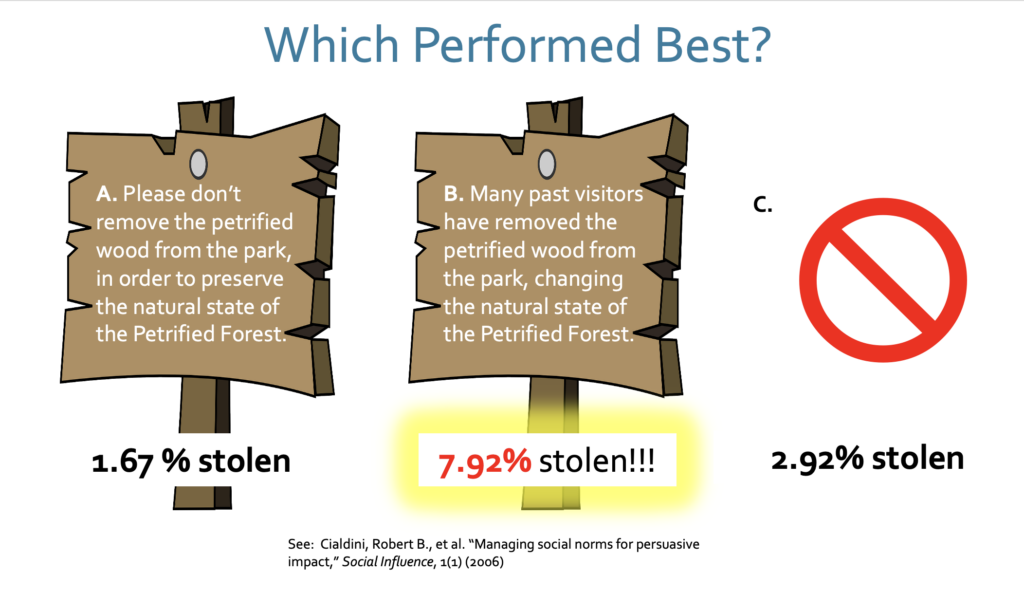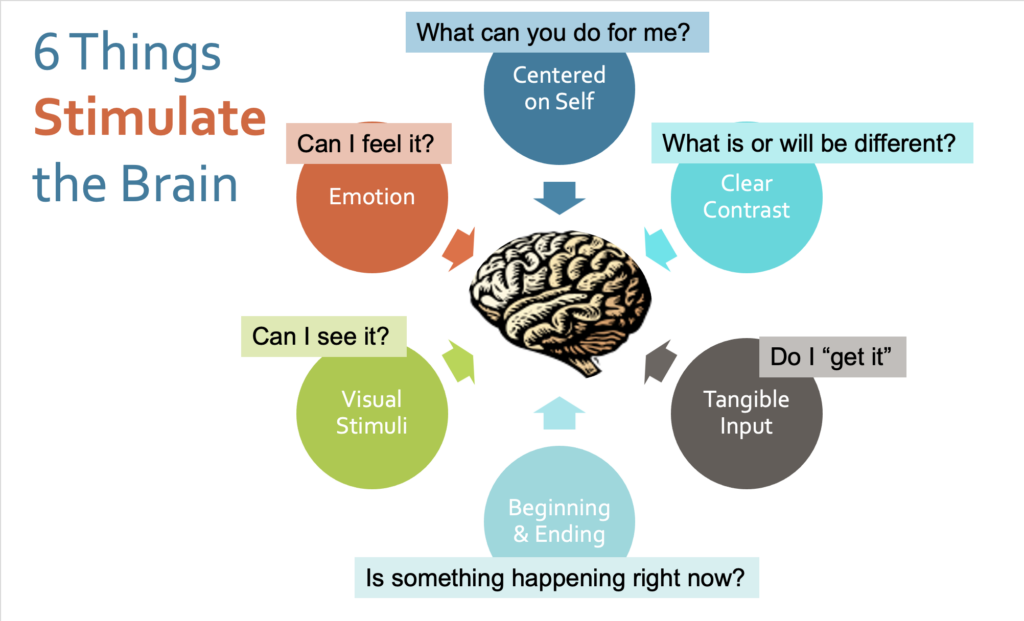Are You Making These Two Mistakes in Your Volunteer Retention Strategies?
When it comes to volunteer retention strategies, your first instincts for how to encourage people to keep coming back might not the best ones.
In fact, they might just shoot you in the foot.
It turns out human beings aren’t very rational in their choices. They don’t purposefully think through a course of action before taking it.
Rather, we behave in predictable ways based on thousands of years of evolution and survival.
In this blog post, we cover two different ways humans are apt to behave, based on how our brains have evolved.
We point out some clear mistakes clear mistakes volunteer-involving organizations and leaders of volunteers may be making that work against their own interest and that of the volunteers who want to make a difference.
In the first, we discover that how norms are communicated can have a clear impact on whether we follow them.
In the second, we review what research has shown really captures the attention of a human brain besieged by a dizzying amount of daily unput.
By merely making a few simple shifts in the approach, volunteer-driven organizations can get more out of their volunteer retention strategies by simply changing how they communicate in these two areas.
Volunteer Retention Strategy Mistake #1: Communicating the Wrong Norms
For example, when in deep need of volunteers and are not at capacity, it may seem that painting a complete picture of your needs and vacancies might engender more sympathy and more response from your existing volunteers.
Surprisingly, research indicates the contrary.
In fact, desperate pleas for help from an understaffed volunteer team, may cast doubts in your audience as to whether the program is worth supporting.
In your audience’s mind, if others aren’t volunteering for you, there must be a good reason. This may plant seeds that cause your existing volunteers to wonder whether their work is meaningful. After all, why won’t others support it?
Social Norms Theory in Practice
Let’s break this down a little further.
Social norms theory suggests that human behavior is influenced by perceptions of how our peers think and act.
Moreover, we are more likely to be influenced by perceived norms (what we view as typical or standard in a group) rather than on the actual norm (the real beliefs and actions of a group).
Here’s an example on how social norms can drive both positive and negative behavior in the environment.
Social Norms in Action: An Experiment
To help reduce the theft of petrified wood artifacts in Arizona’s Petrified Forest National Park, psychologists Robert Cialdini, Steve Martin, and Noah Goldstein designed an ingenious experiment.
The Petrified Forest had long suffered from theft and had used this message: “Your heritage is being vandalized every day by theft losses of petrified wood of 14 tons a year, mostly a small piece at a time” in an attempt to curb theft.
It wasn’t working.
The Test
So, researchers tested the effects of alternate warning signs and included a zone with no sign to control for effects. They placed petrified wood in designated locations.
At the end of each time block, they counted and replaced the removed wood pieces, changed the sign, and began again over a 5-week timeframe.
The two signs read:
“Many past visitors have removed petrified wood from the Park, changing the natural state of the Petrified Forest.” This text was accompanied by pictures of three people taking wood.
“Please don’t remove the petrified wood from the Park, in order to preserve the natural state of the Petrified Forest.” This text was accompanied by a picture of a lone visitor stealing a piece of wood, with a red circle-and-bar symbol superimposed over his hand.
The first sign described what is called an “injunctive norm.” It communicates the rules for the situation and why the rule is important.
The second sign communicated a “descriptive norm” with a picture of what people were actually doing.
The Results
The results were significant.
The first message, where a negative norm is described with a group involved, resulted in a 7.92% theft rate.
The second message, with a more neutral norm and only one person involved, resulted in a 1.67% theft rate.
The control (no sign) resulted in a 2.9% rate (3% with the former signage).
Cialdini concluded that, “It is a serious error to focus an audience on the descriptive norm (i.e., what is actually done in those situations). Instead, public service messages should focus the audience on the injunctive norm (i.e., what is approved or disapproved in those situations).”
Later, Cialdini repeated the study with four different signs and a control.
Similarly, he and his team surmised it is better to use positively worded messages that demonstrate many people complying.
He says to influence an audience, one must communicate “that the desired activity is widely performed and roundly approved, whereas the unwanted activity is relatively rare and roundly disapproved.”
In other words, when communicating with an audience to influence preferred behavior, we would do better to describe how people are already complying, rather than calling out people who aren’t.
Using Social Norms Theory for Your Volunteer Retention Strategies
Imagine how the phenomenon above might be harnessed for successfully volunteer retention strategies
When volunteer retention is an issue, there are often not enough people to get the work done. And the first instinct by leaders of volunteers is to highlight the fact that volunteers are not following through on their commitment, using descriptive norms to show what is happening.
If the descriptive norm is promoted, a larger majority of the audience may not respond, or it may lead more people behave in that way, creating a snowball effect on volunteer turnover.
Alternately, if the desired behavior is promoted, and injunctive norms reinforced, then volunteers may be more apt to reinforce their commitment.
In practical terms, sharing inspiring volunteer testimonials and stories about positive experiences with their dedicated service may be more effective than publicly complaining why people don’t show up.
When designing volunteer retention strategies, nonprofit leaders must be careful what perceived social norms they plan to communicate.
Are you promoting that no one is following through? Or are you promoting that supporting you is good for the community and people are stepping up to the plate?
Your message may make all of the difference in the world.
For more on the psychology of better volunteer retention, check out How to Uncover “Hidden” Expectations for Authentic Volunteer Appreciation HERE >>
Volunteer Retention Strategy Mistake #2: Not Calling on the Emotional Side of the Brain
We all work hard to find, engage, motivate, and retain volunteers and there are hundreds of ways to do this.
But what ultimately makes a volunteer not only choose your organization, but keep coming back? In other words, what makes volunteers continue – again and again – to choose you?
It may have to do with the emotional level of your communications (or lack of it).
Research shows that there is an inner struggle between emotion and reason inside our brains. And our emotional side most often wins.
Turns out, that it is this side of the brain that dictates most of our decisions and actions.
There are three layers in our brain, the evolutionarily oldest and simplest, at the top of the spinal cord, controls basic survival functions like breathing and hunger. Wrapped around this is the ancient limbic system, containing the thalamus, amygdala, and hippocampus which is the seat of basic emotions.
Encasing these older zones is the modern cortex, what we normally recognize as the human brain. The cortex manages hearing and vision, and the prefrontal cortex (at the front of this zone) is the “executive” part of the brain responsible for personality, reasoning, and abstract thought, goals, and planning.
It is the limbic system that triggers empathy and develops a person’s willingness to help. Once that is triggered, then the pre-frontal cortex gets to work.
So, how can we tap into the emotional side of the brain to start or continue the conversation about helping and service?
We must first capture the brain’s attention and then light it up with emotion.
Capturing Attention: 6 Things That Light Up the Brain
In his groundbreaking book Influence: The Psychology of Persuasion, Dr. Robert Cialdini (the same Cialdini from the research study above), identifies six things that stimulate the brain and grabs its attention and stimulates predictable actions.
Turns out that human behavior is often pre-programmed, partly because we cannot process all of the info coming at us each day.
So, we react in stereotypical ways based on cues that tell us, in shorthand, what is going on in front of us.
To guide the way, certain things “light up” the brain and make us pay attention. Below are the things that stimulate the brain, according to Cialdini’s research:
- Centered on Self – The old brain is completely self-centered and what’s to know “what’s in it for me?”
- Clear Contrast – The old brain is sensitive to clear contrasts; in fact, it is always scanning our surroundings for disruptions in the norm.
- Tangible Input – The old brain processes information very quickly, and if waylaid, will forward the info to the new brain.
- Beginnings and Endings – The old brain conserves energy by focusing on beginnings and endings.
- Visual Stimuli – The optic nerve is forty times faster than the auditory nerve, and so it feed info to the old brain much faster. Because of this, humans are hardwired to make decisions largely based on visual input.
- Emotion – The old brain is triggered by emotions and remember events better when they are accompanied by strong feelings
Rather than using rational arguments to support volunteer retention strategies, organizations would do better to tap “human nature” and what stimulates our brains to their advantage.
Using Brain Science to Deepen Volunteer Engagement
Below are some specific examples of how to capture attention and leverage emotions in communications with volunteers:
- Centered on Self – Explain the direct rewards of continued service for volunteers. Convert all communications from org-centric to volunteer -centric by using “you” versus “we” in messaging.
- Clear Contrast – Share examples of before and after volunteer involvement. Make it clear what changes because of volunteer commitments.
- Tangible Input – Check all communications and remove jargon, acronyms, and insider speak. Communicate what is being requested and why it is important in simple, concrete terms.
- Beginning & Ending – Focus on improving volunteer onboarding and first touches to make an exceptional first impressions. Don’t leave new volunteer induction activities up to chance.
- Visual Stimuli – Use photos and video whenever possible in communications. The use of visuals not only grabs attention, it also triggers emotions in a way that the written word cannot.
- Emotion – Share powerful stories of change and transformation and link them back to the impact of continued service and dedication. Celebrate successful and wins with volunteers, small and large. Make volunteering a joyful enterprise.
By using tactics that directly stimulate these areas, you can reach volunteers on an emotional level and help them become feel more deeply engaged with your organization.
For more on how to tap volunteer stories and questions to ask for better testimonials, check out our Complete Guide to Word-of-Mouth for Superior Volunteer Recruitment HERE >>
Brain-based Volunteer Retention Strategies: Key Takeaways
Our brains have been hardwired for thousands of years. So, working against the brain is like trying to stop a waterfall.
Rather why not work with human nature, not against it to keep volunteer coming back in natural ways that work for everyone?
In this post, we covered two brain-based mistakes that many organizations make when it comes to human psychology and offered practical ways to address them.
First, change how we communicate the norms and guidelines for volunteers.
Second, focus on lighting up the human brain and triggering emotions that lead to rational decisions that keep volunteer returning.
By merely making these two simple shifts you can deepen engagement, reduce turnover, and boos the impact volunteers have on your organization, the quality of their experience, and the impact on the community at large.









